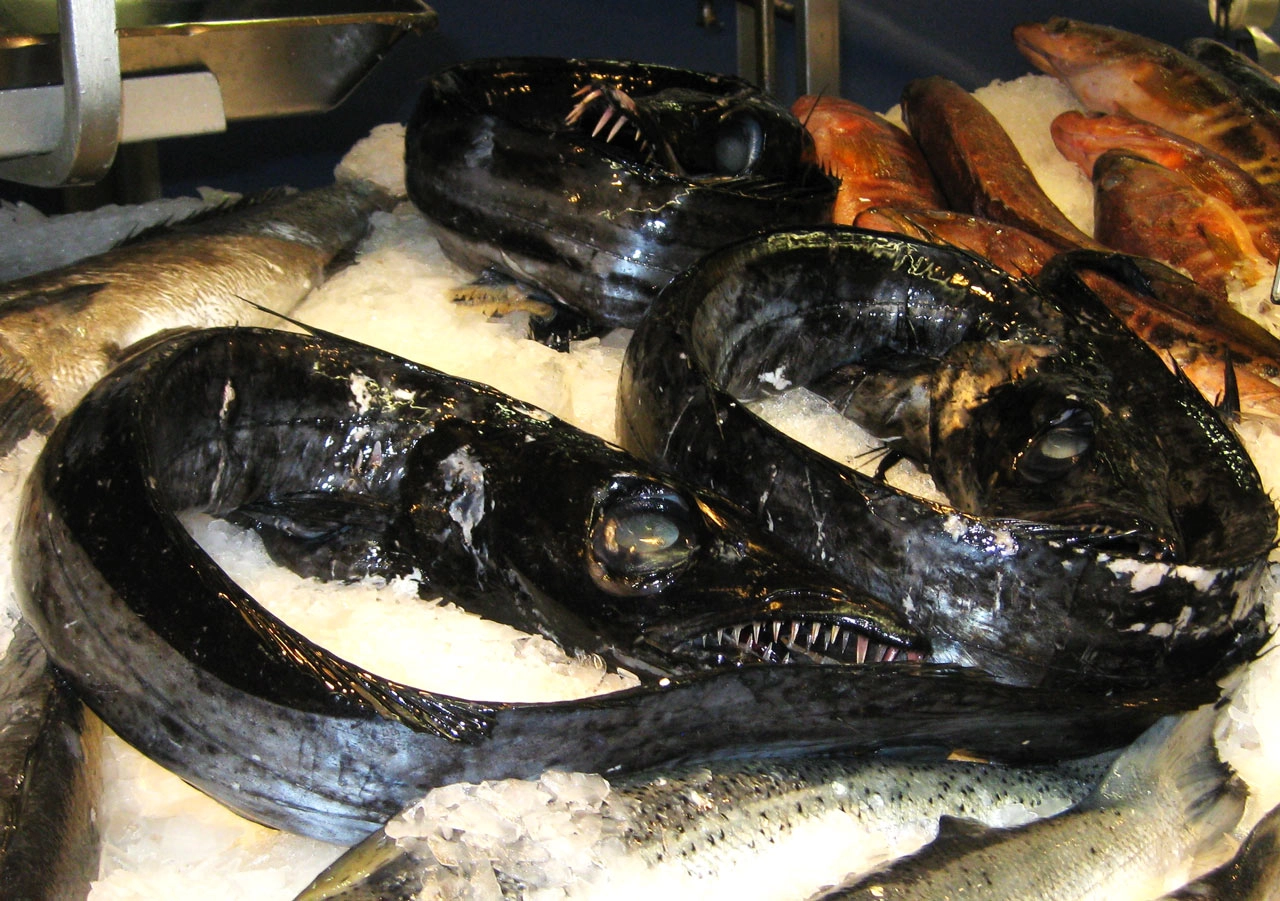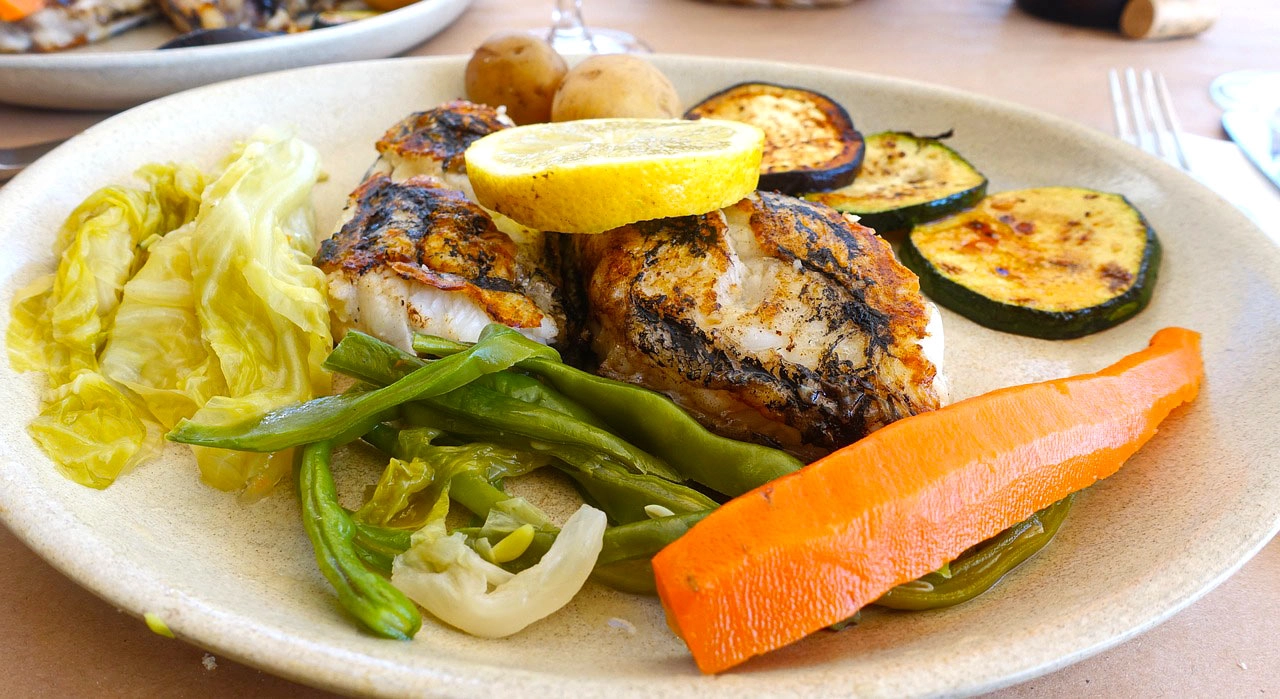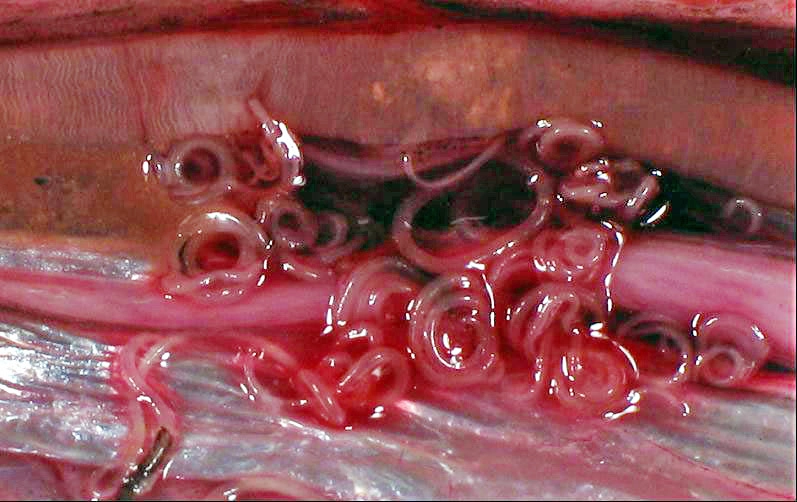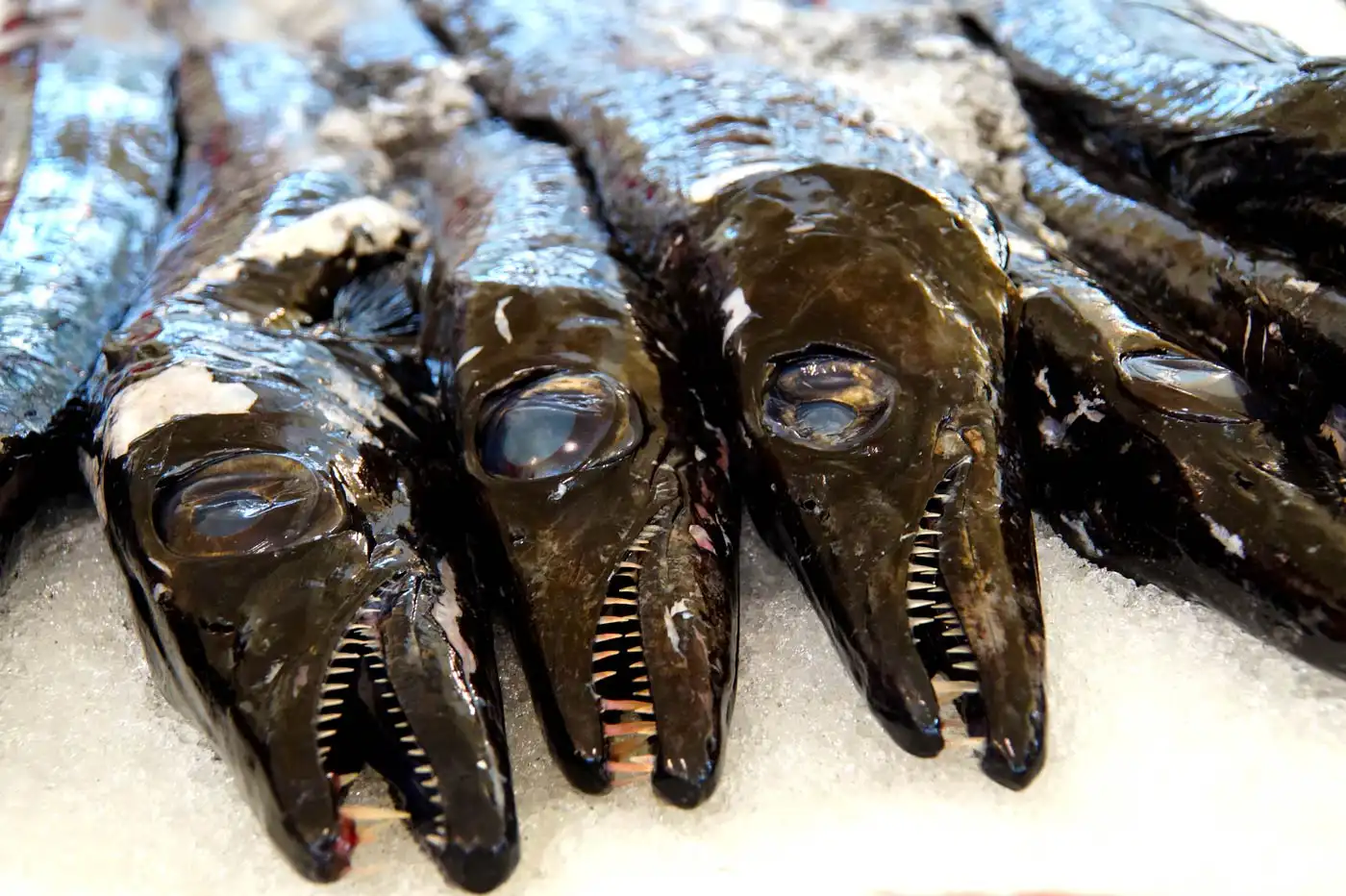Espada or Black Scabbardfish: A Madeiran Favorite
Black scabbardfish, also known as Espada or Espada Preta, meaning swordfish, holds significant cultural importance and ranks among Madeira's most widely consumed foods.
Scientifically classified as Aphanopus carbo, it belongs to the Cutlassfish genus and is found in the Atlantic Ocean, ranging from Iceland to Madeira. Thriving at depths between 200 to 2300 meters, this species is an integral part of the marine ecosystem.
Renowned for its remarkably elongated body, sizable snout, fang-like teeth, and a distinctive coppery-black coloration enhanced by a pearlescent tint, the black scabbardfish has the potential to reach lengths of up to 110 cm and is attaining maturity at approximately 80 to 85 cm.
Females typically exhibit a more elongated body posture, while their notably oversized eyes equip them to efficiently capture light in the depths of the ocean.
Unusual Habitat: Life in Extreme Depths
During the day, the black scabbardfish remains in bathypelagic depths, that is in extreme depths starting at about 1000 meters. The fish is however ascending at night to feed at middle depths (200 meters or more) on a diet, consuming 35 or more types of prey. These include crustaceans, cephalopods, mesopelagic fish, shrimp, teleost fish, and blue whiting.
Until today, the reason why the fish ascends during the night remains uncertain. However, several plausible hypotheses have been proposed:
Its food source plankton requires daylight which is not available in extreme depths.
Water temperature in shallower areas is higher than in deeper waters, providing more energy for hunting.
Nighttime ascent might be a strategy to avoid predators that are more active during daylight hours.

Fishing Espada in Madeira
Intensive fishing of the black scabbardfish had already begun in the 19th century. For a long and until today, it remains one of the most important fishing products in Madeira. The black scabbardfish accounts for over 50% of the total fish caught in Madeira, generating an annual revenue of approximately 10 million euros. Camara de Lobos is the town most well-known for fishing black scabbardfish.
As the fish lives in remote depths during the daytime, fishing exclusively takes place at night. With annual scabbardfish landings exceeding 3000 tonnes in Madeira alone, it plays a crucial economic role for the island.
Scabbardfish are fished using small fishing boats with longlines that reach depths of up to 1,500 meters. The lines are baited with squid to lure the deep-sea predators towards the hooks.
Unlike larger commercial vessels, this traditional fishing method results in minimal bycatch because the longlines are only left in the water for a brief period.
Due to its high-quality flesh, the black scabbardfish scores premium prices on the market. Along with crab, is highly sought-after as one of the most prized seafood products.
How Espada is Served
"Filetes de Espada" is a common dish in Madeira. The fish is filleted, lightly seasoned, and then pan-fried. The fillets are often served with local ingredients, such as banana or passion fruit sauce, thus adding a sweet and tangy flavor to complement the mild taste of the fish.
The combination of the savory fish and the sweetness of either fruit creates a unique and flavorful experience. However, you can find Espada prepared in various ways in local restaurants.

Thinking about making Espada at home? Here's a quick and easy recipe for Black scabbardfish with fried Banana (Espada com Banana). You'll have everything you need, and it won't take more than 20 minutes.
Eating Espada Can Be Dangerous for Humans
Black scabbardfish can host Anisakis, a nematode parasite able to enter a human’s stomach or intestines. Symptoms can be nausea, vomiting or mucus in stool. Eating Espada can be dangerous for humans.
Research has investigated the infectivity of Anisakis. Larvae in black scabbardfish were found in the vicinity of Portuguese waters. The study thus focused on three regions: the mainland coast of Portugal, Madeira, and the Azores.
Scientists monitored the mainland and Madeira regions across four seasons, while the Azores were observed in two seasons. Notably, all scabbardfish examined in the study were found to be infected!
Some people experience a tingling sensation after or while eating raw or undercooked fish or squid. This is actually the worm moving in the mouth or throat. These people can often extract the worm manually from their mouth or cough up the worm and prevent infection.
How to Prevent Yourself From the Infection
It’s easy: do not eat raw or undercooked fish. A general recommendation is to heat the fish to at least 63 degrees Celsius when cooking. Frozen Seafood should be kept at -35 degrees Celsius or less for a minimum of 15 hours. If these recommendations are adhered to, it is safe to eat the fish.
However, since Espada is mostly eaten in restaurants, this can become a bit tricky. In general, you do not need to worry too much, as all restaurants are aware of the potential risk and should take respective measures.
Do also note that Anisakis infection cannot be transmitted from one person to another.
Cure and Treatment of Anisakis Parasite
When it comes to Anisakis infection, some sources suggest that the safest way to deal with it is by removing the parasite through endoscopy or surgery. Diagnosis is typically done using endoscopy or radiography.
Other sources claim that since the larvae are unable to survive In the long run, the body should be able to cope with the infection. Surgery is more likely to be recommended for intestinal or extraintestinal infections when symptoms are prevalent. Oral Treatment with Albendazole for up to three weeks has also been reported to be successful
Please note that this is not professional advice and that you should always inquire with a doctor in case you are experiencing symptoms.

Espada is One of the Most Toxic Fish
Irrespective of these inconveniences, the Black scabbardfish is also considered one of the most toxic fish in the Atlantic. This is simply due to their long life cycle, during which they gather heavy metals such as lead, mercury, or cadmium in the liver.
These metals can be deadly to humans, even in very small amounts. Preparing the scabbardfish thus implies knowing to never eat or touch its liver. If applied, the World Health Organization considers eating the scabbardfish in moderate amounts to have no health risk on humans.
Black Scabbardfish Reproduction & Growth
Black scabbardfish typically reach sexual maturity at ages 3 to 6. In winter, they release their eggs into the open water, and their larvae sustain themselves by feeding on plankton.
The species is known for its relatively rapid growth and reaches approximately 8 years of age. As juveniles, the fish undergo a transition into becoming predators.
Interestingly, in Madeira, Espada tends to live longer, possibly because there are fewer natural predators in this region. The record for the oldest scabbardfish, estimated to be 14 years old, was documented in Madeira.
Nutritional Benefits Of The Black Scabbardfish
Despite the health risks associated with black scabbardfish, it is also a culinary delight and offers several nutritional benefits. Here are some key aspects of its nutritional profile.
Proteins & Omega-3
Protein: Espada is an excellent source of high-quality protein, essential for muscle repair, growth, and overall body function.
Omega-3 Fatty Acids: It contains some omega-3 fatty acids, the fish thus contributes to heart health by helping to reduce inflammation, lowering blood pressure, and decreasing the risk of heart disease.
Vitamins
Vitamin D: Important for bone health, immune function, and mood regulation.
B Vitamins: Contains several B vitamins, including B12, which is crucial for nerve function and the production of red blood cells.
Minerals
Selenium: Acts as an antioxidant, helping to protect cells from damage.
Phosphorus: Vital for healthy bones and teeth, as well as energy production.
Iodine: Essential for thyroid function and metabolic regulation.
More Health Benefits
Espada is relatively low in calories, making it a good choice for those looking to maintain a healthy weight while ensuring they receive the necessary nutrients. Furthermore, While it provides beneficial omega-3 fatty acids, it is generally low in total fat, contributing to a balanced diet. Incorporating black scabbardfish into your diet can provide a range of health benefits, making it a nutritious option for seafood lovers.
Espada Conservation Challenges
Despite its economic significance, Espada is under a significant threat from overfishing, making it highly vulnerable. Conservation efforts are essential to protect the species.
As of 2018, The IUCN Red List of Threatened Species lists the black scabbardfish as "Least Concern”, likely because it still exists in abundance despite its vulnerability.
However, the Marine Conservation Society acknowledges the species' crucial role in the ecosystem but notes a decline in abundance in specific areas of the Northeast Atlantic. This underscores the necessity for ongoing conservation measures.
Last Update: 21.05.2024






Comments